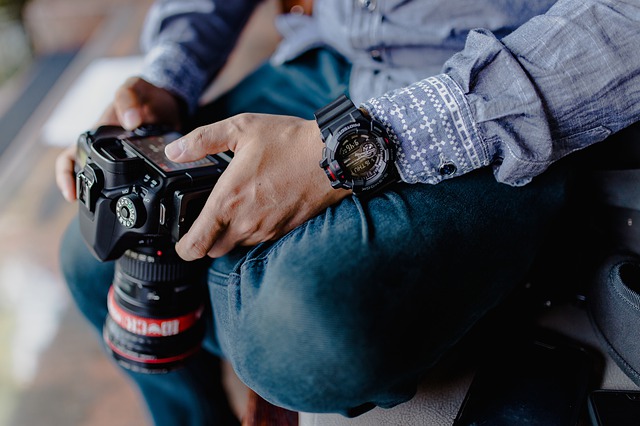Whether you’re a beginner or a pro, it’s always handy to learn new photography tips and tricks to take your work to the next level. New research from Canon has gathered insights from four professional photographers who specialise in different styles of photography including fashion, food, travel and family. Below, they reveal their top tips on how they produce outstanding work for their clients.
1. Understand what your photographing
Professional food photographer Sid Ali says, “One of the biggest misconceptions in food photography is that it’s easy and anybody can do it. But what food photography really relies on is a deep understanding of the food that you are photographing.” In-depth research about the culture and the food you want to capture can help to generate new ideas for more ‘unique’ shots. He also advises you, “to never stop being inspired and to never stop shooting.” Take time to observe all aspects of your life – from the books that you read to the conversations you have with different people. You never know when these day-to-day exchanges could spark an idea or a new piece of work.
2. Make the most of your time
Richard Bernabe, a professional travel photographer states that, “If you’re short on time on your travels, I suggest you wake up super early – before sunrise – so you can explore without crowds or tourists. The morning light is magical and you’re most likely to have the best locations to yourself.” Getting up at the crack of dawn might be hard, but capturing the perfect, tourist-free image will be worth it. It can also free up more time to see what location works – or doesn’t – so you can adjust your shooting schedule accordingly.
3. Keep your subject engaged
Hannah Harding, a professional family photographer, suggests the best way to get great candid shots is to keep children engaged. “Chat to them before you start the shoot. Ask them what their favourite food is. I find: ‘Can you think of the biggest bowl of chocolate ice cream in the world?’ works wonders if I want a magical smile”, Harding says. These natural shots occur best when you get to know your clients and make them feel comfortable with both you and the camera.
Saurabh Dua, a fashion photographer, agrees and adds that one of the most difficult things for a fashion photographer is to ensure that the picture is not too ‘pose-y’.
“Encouraging the model to be candid, yet creating a strong presence is what challenges me the most”, Dua says. Candid shots can offer an authentic depiction of your subject, but they can be hard to capture. As a photographer, you always have to be in the moment when on set, ready to snap your subject – even when they’re not posing.
4. Step back
A bit of distance never hurts to get a good scope of your surroundings, which works well in both life and photography. Bernabe advises that, “the natural impulse of most photographers would be to zoom in tight on the subjects they’re trying to capture. But sometimes the wider composition is the stronger one.” Let nature and your location do the heavy lifting and tell the narrative of your shot, setting your work apart from your competition. The beauty of it is that if it’s not quite what you’re looking for, don’t be afraid to move around and change positions to make it work for you.
5. Planning is key
When you’re prepared, there are more chances of things going right when you’re on set and doing the groundwork before a shoot is a big part of Dua’s photography process. “While you can be spontaneous on a shoot, it’s important to plan everything out meticulously first. When you know that everything has been organised and all the team are prepared, it’ll be easier to improvise (and then come back to the plan when you’re done)”, he says. There is a lot of time, effort and work that goes into head-turning shots and being prepared means you can seize opportunities more easily. Preparation is also something that Bernabe believes in, saying, “a misconception about the type of photography I do is that I am out, travelling and taking photos all the time. But the vast majority of my time is spent writing, planning, doing promotions and marketing.” Successfully producing high quality work can mean putting as much effort into sourcing clients, creating and maintaining a website, and preparing for a shoot as much as getting the actual shot.
6. The more the merrier
Ali suggests that, “Sometimes the best way to get the shot you want is to get five different shots and composite them together in Photoshop. Take as many shots as you can so you give yourself and your retoucher as many options as possible”. When it comes to professional photography, it’s not unusual for a lot of the work to be done after the shoot, so set yourself up for success and snap as many photos as you can while you’re in the moment. This can make piecing together an amazing shot for your client a much easier process.
7. Actively seek critiques
When trying to create something great, it’s important to make mistakes and learn from them. Dua adds that, “Photography is an art form, but it comes with a lot of practice and continuous hard work. You need to learn from your mistakes as well as critically analyse your work on a regular basis.” Take examining your own work a step further by seeking critiques from other professionals that inspire you and ask them for feedback on your work.
Although, when asking for feedback remember that art is subjective: people will be honest about your work, so with the good also comes the bad. Take on board any criticism and implement changes that you think will make your work better.
8. Let there be light
Lighting is vital for a photographer’s composition and, with the right manipulation, can make or break a shot. Dua says that, “every fashion photographer has a unique way of lighting their models. Develop your skills gradually until you come up with a unique style of your own. Eventually, you’ll have a strong identity that people will recognise instantly as your own”. To really get to grips with lighting as a beginner, Ali recommends, “use natural lighting so you understand how it works. Experiment with shooting on a sunny day, and then shooting on a cloudy day. Once you understand how natural lighting works (and how to use it) you can move on to artificial sources of light.” Mastering different levels of light takes tenacity and time, so practice and experiment to achieve a whole range of moods for your shots.
9. Patience is a virtue
No matter the subject you’re snapping, from landscapes to people or animals, being patient will always come in handy. Family photographer Hannah Harding agrees, “patience [will be your] most important strength”. Whether it’s waiting for the perfect natural lighting to illuminate your location, an animal to finally emerge, she adds that, “children can be unpredictable and have the ability to be gloriously stubborn at times. If you lose your cool, you lose their willingness and trust.” Taking the time to get to know your clients will help you to get you the results you’re looking for in your final shots.
10. The rule is: there are no rules
Bernabe and Dua both agree that there are no set rules in photography. “You can break and mould whatever you like, and no one is going to stop you,” says Dua. In fact, when you don’t follow any rules or patterns, “it only makes the image more unique and gives intense joy and delight,” says Bernabe. By following your creative instincts, you can develop your individual style and create pieces of work that stand out from the rest.
Whether you’re shooting for a client or to add to your own personal collection, there are always new photography tricks you can learn to improve the quality of your work.





